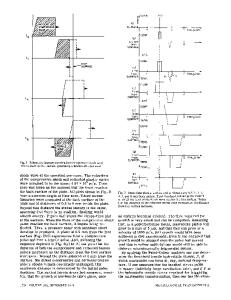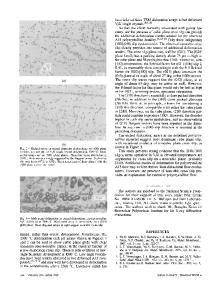On the Martensitic Transformation in V 3 Si
- PDF / 2,263,281 Bytes
- 10 Pages / 414 x 635.4 pts Page_size
- 21 Downloads / 365 Views
ON THE MARTENSITIC TRANSFORMATION IN V3Si F. WEISS, 0. DEMOLLIENS, R. MADAR, M. COUACH* AND J.P. SENATEUR E.R. 155 - C.N.R.S. - E.N.S.I.E.G. - B.P. 46 38402 SAINT MARTIN D'HERES - FRANCE * SBT Lab. de Cryophysique C.E.N.G. - B.P. 85X 38041 GRENOBLE C~dex - FRANCE -
ABSTRACT
We demonstrate unambiguously that V5 Si 3 inclusions coherent with the V3 Si matrix induce at low temperature a tetragonal distorsion of V3 Si. a)Polycrystalline samples are transforming only if they are two phased V3 Si - V5 Si3 , b)the oriented eutectic V3 Si - V5 Si 3 undergoes a cubic - tetragonal distortion under 60K. c)A transforming V3 Si crystal is obtained by solid state epitaxy of a V5 Si 3 layer on the (001) plane. These experiments support very well our idea that the distorsion can be driven by internal stresses in the samples, related to silicon over stoichiometry.
INTRODUCTION
There is a great deal of interest for A15 superconductors, where, up to now, the highest superconductive transition temperature has been found. These materials show frequently anomalies in their electrical, magnetic, elastic and structural properties. For two of these compounds (V3 Si, Nb3 Sn) it has been unambiguously shown that a tetragonal distorsion of the lattice may occur above Tc. Theoretically, this transition is well explained and models have alrea*y been proposed [1,21 which lead to the conclusion that the
transition is electronically driven, and that a lattice instability occurs at low temperature, the Fermi level.
in relation with a sharp peak of density of state near
Experimentally, although many works have been done on these compounds, the problem remains a puzzle since the transition is very sensitive to stoichiometry and defects, so that many results, which may be classified as sample dependent, remain unexplained. In fact, in some cases, the transition takes place only in one part of a single crystal, and it seems up to now
that it is impossible to define a priori the experimental conditions which lead to a transforming sample. It is well established that a high resistivity ratio R = R30OK/R20K is a good test for the transforming character of a V3 Si sample (if R is >20 the crystal is generally transforming). Many experimentators conclude that perfect ordering is a necessary condition for the transformation, and this is in good agreement with the theory based on the existence of infinite and perfect V or Nb chains running along the 4100) axis. But some experiments have pointed out that certain type of defects would have an important role in the effective occurence of the transition. It is now evident that a high resistivity ratio is not a clear test for the high ordering quality in the samples, since polycristalline materials containing important amounts of heterophase inclusions lead to resistivity ratios comparable to those of "good" crystals [3,this study]. We have proposed a mechanism for the transformation based on strong structural relations between V3 Si and V5 Si 3 [4]. The structural analogy Mat. Res. Soc. Symp. Proc. Vol. 21
Data Loading...











